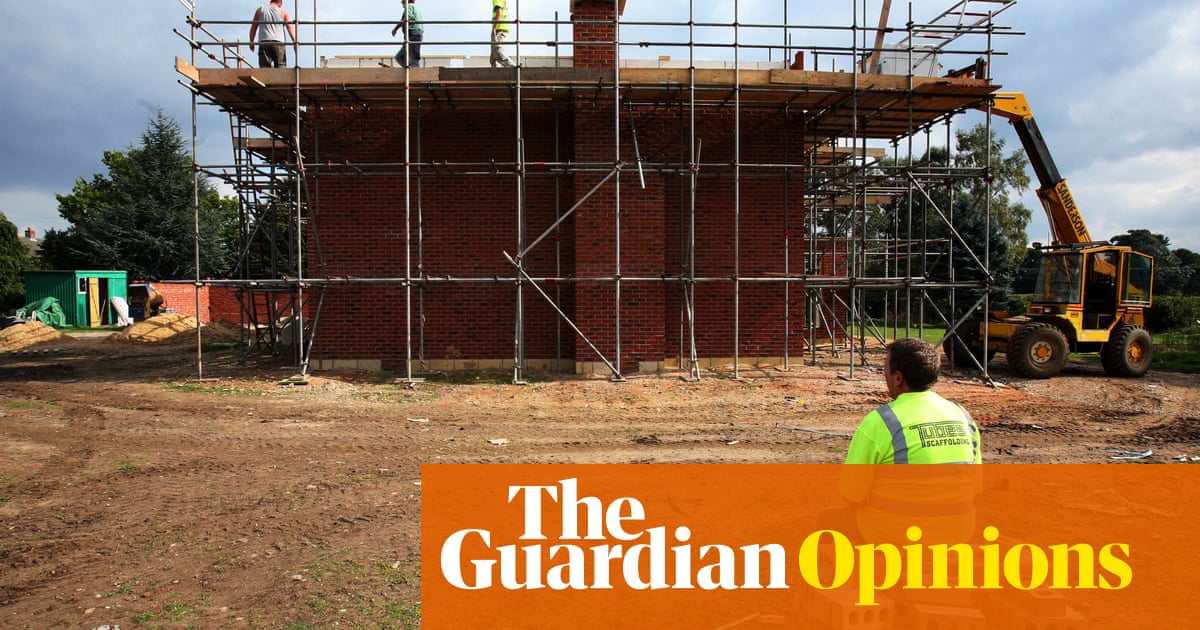Photo credit: www.theguardian.com
In the wake of the Office for Budget Responsibility (OBR) significantly revising its growth forecast, one notable prediction has gained less attention than it deserves. The OBR anticipates that housebuilding will surge to its highest level in four decades, contributing an additional 0.2% growth, approximately £6.8 billion, by the year 2029-30, with projections suggesting this could increase to over 0.4% by 2034-35. The government has highlighted that housing offers the most substantial positive growth impact from a “zero-cost policy” that the OBR has forecasted.
This forecast stands out particularly when considering that 2024 experienced a record low in the number of planning permissions granted for new home developments, as reported by the Home Builders Federation (HBF). After the previous government abolished mandatory housing targets for councils, planning applications saw a dramatic decline. However, following the Labour government’s reintroduction of a national planning policy framework, such applications have increased by over 160%.
The OBR is optimistic that Labour’s Angela Rayner will achieve close to 1.3 million of her ambitious 1.5 million new homes goal. Yet, this estimate does not consider the ongoing planning act in parliament, which aims to eliminate various barriers to development. Additionally, last month’s announcement of £2 billion investment to support what is being called the most significant increase in social and affordable housing in a generation, including the potential for 18,000 new homes, was also excluded from the OBR’s growth calculations.
Moreover, the OBR failed to factor in the newly launched “new homes accelerator” initiative, designed to expedite the planning process by sending in experts to unblock bottlenecks affecting thousands of new homes, including on seven recently identified sites. There are also more than 100 proposals under consideration by the new towns taskforce, which is expected to make its report this summer. The government suggests that these initiatives will help meet the housing target of 1.5 million new homes.
As reform efforts intensify, the need for legislative change is urgent. Previous attempts at reform faced resistance from Conservative MPs worried about developments in their constituencies. The experiences of Stonewater, a social housing provider, illustrate the sticking points in the current system. The agency aims to construct 1,000 social homes annually, having secured significant investments of £200 million in 2023 and £250 million in 2021, while managing a portfolio of 40,000 homes. However, many of their projects are mired in lengthy council planning processes.
According to Stonewater, there are legally mandated response timelines for planning applications, yet the absence of penalties leads to extensive delays. One application has been stalled for two and a half years in Frome, while a similar project for 62 homes in Worcester took almost as long. They currently await permission for a development in Lutterworth, Leicestershire, which has been pending since they purchased the land in October 2021.
In another example near King’s Lynn, Norfolk, Stonewater secured land for building 87 homes but still awaits a permit despite an outline agreement. Jonathan Layzell from Stonewater pointed out that while private developers can afford to wait out planning delays, social housing providers depend on steady rental incomes and face severe financial pressure due to these hold-ups. He further highlighted the stigma associated with social housing in rural areas, indicating that community resistance often complicates the approval process.
Council planning committees sometimes bypass the recommendations of professional planners for political reasons, leading to costly outcomes when developers subsequently appeal. This issue highlights the need for the forthcoming planning bill, which aims to limit the power of local planning committees, transferring more decision-making authority to qualified professionals. The revised structure will ensure that councillors involved in planning decisions possess adequate training and credentials.
While these advancements signal a positive shift, significant hurdles remain, particularly the chronic shortage of experienced planners. In King’s Lynn and West Norfolk, for instance, Stonewater’s application has been delayed since 2021 due to planning resource constraints, exacerbated by other contentious local projects.
The new Labour administration is advocating for a local plan, doubling housing site allocations but facing local pushback against more housing projects. Independent councillor Jim Moriarty, responsible for planning in the district, remarked on the extensive effort required to draw up the local plan and expressed support for the new planning legislation, even as local sentiment tends to resist additional housing.
Moriarty noted recent staffing improvements, having added two new planners to the team but still requiring more to meet the growing demands. The HBF has indicated that many councils are operating with a planner workforce that is 40-50% below capacity. The Royal Town Planning Institute reported a concerning trend of experienced planners leaving the public sector for private opportunities, complicating retention efforts. Although the government has pledged to recruit 300 additional planners, industry stakeholders suggest that an influx of 7,000 planners is necessary to adequately meet housing demands.
An additional challenge lies in staffing the construction sector. The HBF states that developing every additional 10,000 homes necessitates 30,000 new workers, raising a critical question for Labour about immigration policies in relation to meeting housing targets through skilled migrant labor. Public sentiment reflects a cautious approach toward migrant workers in construction, revealing a divide that could influence Labour’s strategies moving forward. Nonetheless, achieving the ambitious housing goals outlined could serve as a pivotal point for Labour’s reputation.
Source
www.theguardian.com

